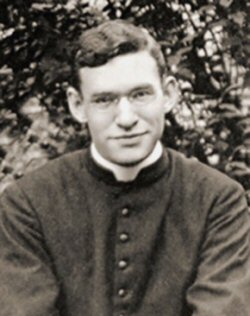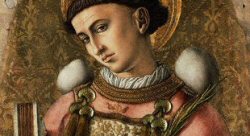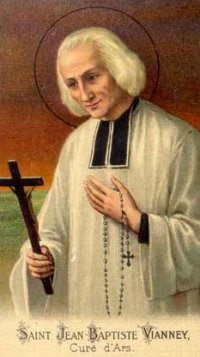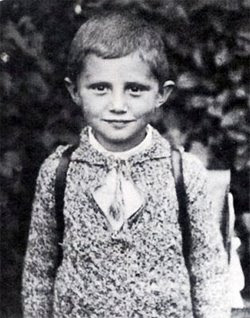From the
Washington TimesBy Gabriella Boston
She's an Army captain, a Catholic sister and a doctor.
Deirdre Byrne wears many hats — quite literally: a scrub hat when she's doing surgery and a habit as part of her everyday attire.
The statuesque, graying 52-year-old recently exchanged her habit for a helmet and uniform: She spent three months in southern Afghanistan, serving as a doctor (while treating patients, though, she wears scrubs) and reservist in the U.S. Army.
"We were there to support our U.S. soldiers, coalition forces and civilians," Sister Dede says. Turned out that most of her and the other medical staffs' effort and time were devoted to mending civilian lives and limbs.
"The Taliban is out there every day trying to wreak havoc," she says. "One day, the Taliban bombed a village, and we had 17 patients — flown in by helicopter — in our 10-bed hospital."
While gruesome and heart-wrenching, she says of the experience in Afghanistan: "I was happy to be at the healing end of things."
Which is what she does whether serving as a nun and doctor for the poor in the District or Kakuma, Kenya, through Catholic Charities, or as a U.S. Army doctor in Afghanistan.
She's a healer, and in her unique position as a nun and general surgeon (she also is board certified in family medicine) she's concerned with life here on Earth — and the hereafter.
"I'm not just a pro-life doctor, I'm pro-eternal life," she says. "God makes it very clear that he is working through me. … God gave me the opportunity to be a physician, and he creates the miracles."
But how exactly did she get to this triad of professions and callings?
As one might expect, it was not a straight path but just the kind of winding, long road that seems a prerequisite for the type of person Sister Dede is — someone who seems to easily move in any circle but whose ideals and faith never waver.
Lighting the way
Sister Dede is sitting in the unofficial pharmacy of the Spanish Catholic Charities clinic in the District's Mount Pleasant neighborhood, a room so stuffed with medication — mostly donated — that a wrong turn or step could cause a pill-bottle avalanche.
She volunteers full time at the clinic, treating immigrants — many of them from Central America; some legal, some illegal — for everything from bumps and spider veins to cancers.
"For me, God doesn't show floodlights," Sister Dede says. "He sheds just enough light for me to take small steps forward."
She hasn't yet made her final vows as a sister (a term preferred to "nun" — "sister" indicates an active, worldly role as opposed to a convent-based, contemplative life, she says). But Sister Dede has known since adolescence that she wanted to devote her life to serving God and healing the poor.
"It took me a long time to find a community," she says.
In 2000, though, she found her future spiritual — and literal — home, Little Workers of the Sacred Hearts, not far from the Basilica of the National Shrine of the Immaculate Conception in Northeast: A place where she could serve the medical needs of the poor while also serving God.
"What I saw was God asking me to start a medical branch of an established community," she says. "The Little Workers of the Sacred Hearts was that community."
Military, medicine, mission
Way, way before then — in the late 1970s — she joined the Army and went to medical school at Georgetown University (following in the footsteps of her father, a retired thoracic surgeon and alumni of Georgetown).
Joining the Army initially was just a way to pay for medical school, but it grew in significance.
She found that she also could do God's work while serving as an Army doctor. In 1985 and 1986, she served as an active-duty Army doctor in Egypt's Sinai desert, where she started a group called the "Sunshine Club" that helped female soldiers "stay chaste and true."
"We'd just go down to the Red Sea — it was very beautiful — and talk about how to stay strong, and about the pressures to do things they didn't really want to do," she says. "I was their mama."
As it turns out, though, she wasn't just a role model and spiritual leader for those young women. A scrapbook from the tour shows a deep appreciation from male soldiers, too.
"Your caring attitude is an inspiration to all of us," a major wrote.
"Thank you for all the help you have given me in both my work and my spirit," added another.
"I have worked with a lot of physicians in my career, but none have shown the compassion that you have shown toward the troops here," wrote another.
Being called compassionate, though, was nothing new to Sister Dede.
Her 92-year-old mother, Mary Byrne, still lives in McLean, Va., not far from the home where she and her husband raised their eight children.
"We had a dog, and I didn't want it to go upstairs," Mrs. Byrne recalls. "Well, Dede, after I'd gone to sleep, would sneak downstairs to sleep with the dog on the floor. She didn't want it to be lonely."
The dog got to come back upstairs so young Dede could go back to sleeping in her own bed.
"She was always compassionate. She was always religious," Mrs. Byrne says. "Her path never really surprised me."
But there's also this other side that at first glance doesn't necessarily jibe with the life of a nun.
"Dede always had lots of fun, too. … We're all like that in our family," says Mrs. Byrne of her large Catholic clan. "We do a lot of sarcasm and it gets us in trouble sometimes."
Sister Dede always wears her habit at the Spanish Catholic Charities clinic where she's worked for the past eight years after "paying back" the Army for medical school and specializations in family practice and surgery.
She also sprinkles most conversations with jokes, some of which can be surprisingly irreverent.
"No, I haven't been drinking. Won't be doing that until I get home tonight," she says, joking about a flash of forgetfulness one morning at the clinic, which treats about 7,000 uninsured patients annually.
This is the same day that she tells a colleague, retired general surgeon Dr. Paul Melluzzo, a volunteer at the clinic, that he is, well, ancient.
"Surgery was started by barbers in the Middle Ages," she says. "Remember that, Dr. Melluzzo?" she inquires with a twinkle in her hazel eyes.
"I heard that," Dr. Melluzzo says, smiling.
He is one of several retired doctors Sister Dede persuaded to volunteer at the two-story clinic, which also has 14 paid employees (the clinic is funded by private donations and some government grants as well as funds from the Archdiocese of Washington and Catholic Charities).
"She came to me and said, "Come to the clinic, it'll be good for you," Dr. Melluzzo says.
That was two years ago.
"And you don't say no to Sister Dede," he says. "This is Sister Dede's bear trap."
Dr. Melluzzo picks up his briefcase from a small administrative room at the clinic, which has five examination rooms on the first floor and several dental chairs on the second.
A "Spanish Now" workbook sticks out of the briefcase — Dr. Melluzzo is taking Spanish lessons to improve his communication with the mostly Spanish-speaking patients.
"I think we all should give back, and this is my way of giving back," he says.
A day at the clinic
The waiting room — often packed — has a framed poster of Our Lady of Guadeloupe, and on the second floor there is a small chapel. Other than that — and the habit-wearing Sister Dede — the clinic looks like any medical office.
Well, with a few exceptions. The equipment is donated and looks aged. Sometimes it means working in substandard conditions — like when Sister Dede and medical resident Dr. Cory Chapman excised a patient's ingrown hair and drained a cyst with a tiny scalpel blade without the holder.
"It's bush medicine in the city," says Sister Dede, holding the tiny blade.
The patient with the ingrown hair is a Mexican delivery man who speaks limited English.
"Lo siento, lo siento," says Dr. Chapman, apologizing as he cuts out a cyst that surrounds the hair.
"You'll hear us say 'lo siento' a lot," says Sister Dede, who, in her very unique position, also has strong ties to Sibley Hospital in the affluent Palisades neighborhood of the city.
Many of the doctors with whom she went to medical school at Georgetown University have privileges there. So, now, whenever she needs an operating room, the hospital provides.
"Thanks to her, we have all the contacts at Sibley," says Cecilia Alava, a retiree who volunteers at the clinic as an interpreter and also fills whatever other role is needed.
"Sister Dede is the best. Without her, the clinic would go down," she says.
Sister Dede calls the hospital "St. Sibley."
Which was where, last summer, she performed surgery on Marshet Zema, a petite native of Ethiopia with a beautiful smile.
When Sister Dede first met Ms. Zema, the 21-year-old had fist-sized keloids (lumps of scar tissue) behind her earlobes.
"We'll remove these and create an earlobe," said Sister Dede, tracing her thumb and index finger along the keloids at the June visit.
Ms. Zema had worn a scarf day and night for the past three years to cover up the deformity.
"Thank God," said her brother, Desalane Zema.
"We have been to every hospital in the city, and no one will treat her because she doesn't have health insurance," Mr. Zema says.
Sister Dede, though, never discriminates.
She treats the poor and the illegal for everything from small medical conditions to big emergencies at the clinic. The same day that Ms. Zema came in for her pre-operation visit, a middle-aged woman with a perfect pedicure came in to get her spider veins removed.
"These are not dangerous, but we'll remove them," Sister Dede says while holding the woman's leg.
She then proceeded to inject saline into the woman's veins, which takes away the discoloration.
"This is with holy water, so you better believe it works," jokes Sister Dede, whose sandal-clad calloused feet stand in sharp contrast to the patient's perfectly painted nails.
The woman smiles.
Sister Dede, though, doesn't judge.
She's there to heal.
"I'm a private practitioner to the poor," she says.
Adds Mario Dorsonville, a priest and the clinic's director: "We are so fortunate to have Sister Dede," he says. "She's amazing."
It's not about success
To Sister Dede, none of her accomplishments are about personal glory. Whether in the military or in civilian life, her work, she says, is about faith and doing God's work.
"The Lord has worked so many miracles in my life, it's not even funny," she says.
Obtaining three $50,000 portable sonogram units, she attributes to God.
Meeting Sister Licia, the superior sister at the Little Workers of the Sacred Hearts, she attributes to God.
Each person she successfully treats, she attributes to God.
She attributes to God the existence of a physical therapy clinic in the basement of the Little Workers of the Sacred Hearts' small brick building, where volunteer physical therapists treat the uninsured on Saturday mornings.
"It's not about my being successful or brilliant," she says. "It's about God guiding me."
She felt this guidance even before she officially entered religious life.
"God would always let me know if I did something that wasn't holy or wholesome," she says.
As a child — before she decided she wanted to become a nun — she was inspired by the selfless work of Mother Theresa.
"She seemed to move me when I was in high school," she says. "She inspired me."
And with her combination of missionary work as well as taking care of the poor and the sick, one can't help but wonder:
Is Sister Dede a new Mother Theresa?
"I don't see myself that way," she says. "Mother Theresa was an inspiration to me growing up. But this is not about me or about my success. It's about God's work."
Ms. Zema and her brother might disagree.
On a post-operation visit at the clinic, a radiant Ms. Zema sports her scarfless and keloidless head and her new earlobes, courtesy of well-known area plastic surgeon Al Fleury, also a friend of Sister Dede.
"Oh my God," she says. "I'm so, so happy," she says, a slight quiver in her lower lip.
Adds her brother Mr. Zema of Sister Dede: "She's working miracles."
 "Our primary mission is to support the mission here by providing spiritual, religious and ethical support for members," said Dion, a permanent Roman Catholic deacon who has been stationed here for four months. "We provide a ministry of presence." (Photo at left shows Deacon Michel Dion in uniform on the right)
"Our primary mission is to support the mission here by providing spiritual, religious and ethical support for members," said Dion, a permanent Roman Catholic deacon who has been stationed here for four months. "We provide a ministry of presence." (Photo at left shows Deacon Michel Dion in uniform on the right)










 CFR Postulant Class - 2008 (l-r) Aaron Ocello (NJ); Oisin Martin (Ireland); T.R. Hoffman (CA); Bob Monahan (IL); Alan Fimister (England); Joe Fino (OH); Larry Napier (GA); Declan Gibson (Ireland); Stephen Dufrene (Louisiana); Alain Guiteau (NY); Emmanuel Pena (NY); Matthew Bourgeois (LA); Mike LeFever (VA); Matthew Manders (IA); Eric Forrest (GA); Kris Meiergerd (KS); Fr. Luke Fletcher, CFR, Postulant Director; Fr. Gabriel Bakkar, CFR, Vocation Director.
CFR Postulant Class - 2008 (l-r) Aaron Ocello (NJ); Oisin Martin (Ireland); T.R. Hoffman (CA); Bob Monahan (IL); Alan Fimister (England); Joe Fino (OH); Larry Napier (GA); Declan Gibson (Ireland); Stephen Dufrene (Louisiana); Alain Guiteau (NY); Emmanuel Pena (NY); Matthew Bourgeois (LA); Mike LeFever (VA); Matthew Manders (IA); Eric Forrest (GA); Kris Meiergerd (KS); Fr. Luke Fletcher, CFR, Postulant Director; Fr. Gabriel Bakkar, CFR, Vocation Director. 







 (Photo above) After the consecratory prayer, I receive a veil, a ring, and a breviary. Here, I am receiving the Liturgy of the Hours, with the commission to pray.
(Photo above) After the consecratory prayer, I receive a veil, a ring, and a breviary. Here, I am receiving the Liturgy of the Hours, with the commission to pray.






























